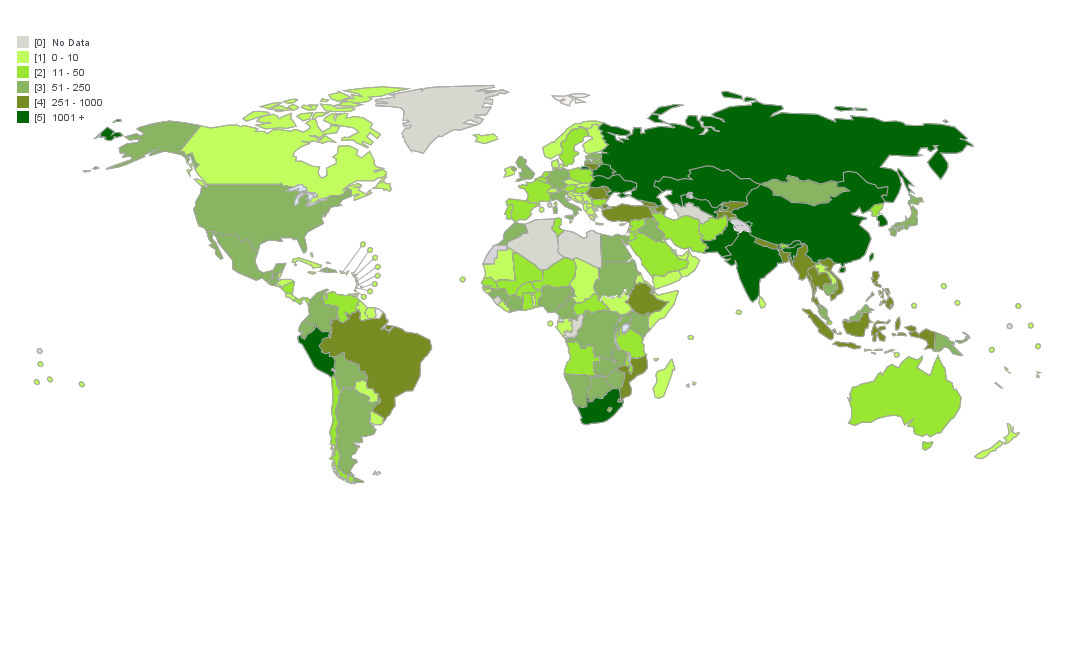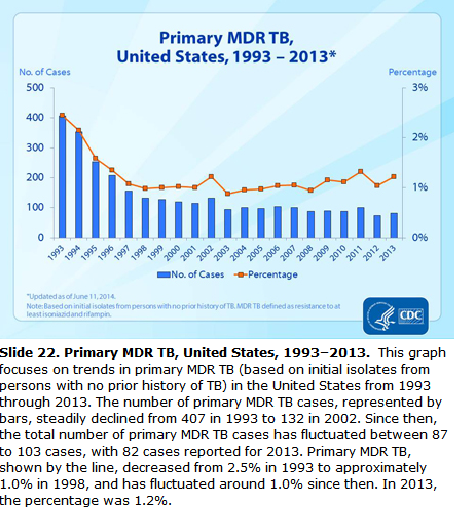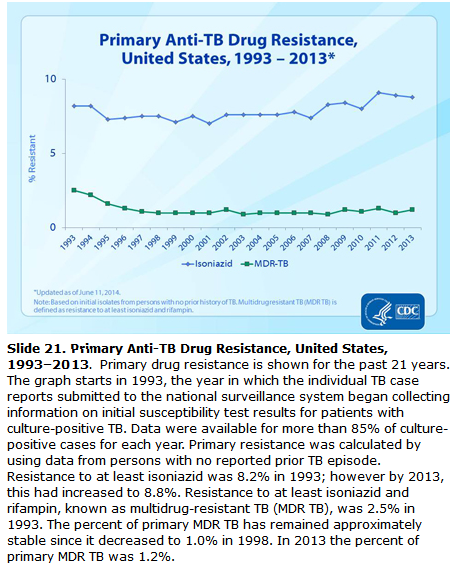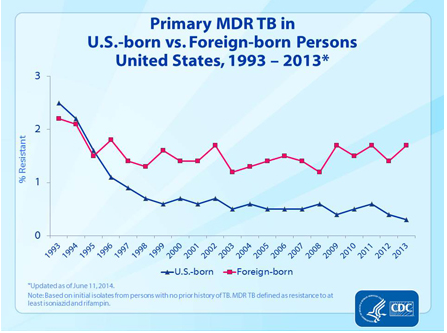Multi-drug-resistant tuberculosis epidemiology and demographics: Difference between revisions
No edit summary |
No edit summary |
||
| Line 33: | Line 33: | ||
|valign=top| | |valign=top| | ||
|[[File:Primary MDR TB in U.S.-born vs. Foreign-born Persons, United States, 1993–2013..png|thumb|600px|Primary MDR TB in U.S.-born vs. Foreign-born Persons, United States<SMALL><SMALL>''[http://www.cdc.gov/mmwr/preview/mmwrhtml/mm5005a1.htm/ Adapted from Centers for Disease Control and Prevention.]''<ref name="PHIL">{{Cite web | title = Public Health Image Library (PHIL), Centers for Disease Control and Prevention | url = http://www.cdc.gov/mmwr/preview/mmwrhtml/mm5005a1.htm/}}</ref></SMALL></SMALL>]] | |[[File:Primary MDR TB in U.S.-born vs. Foreign-born Persons, United States, 1993–2013..png|thumb|600px|Primary MDR TB in U.S.-born vs. Foreign-born Persons, United States<SMALL><SMALL>''[http://www.cdc.gov/mmwr/preview/mmwrhtml/mm5005a1.htm/ Adapted from Centers for Disease Control and Prevention.]''<ref name="PHIL">{{Cite web | title = Public Health Image Library (PHIL), Centers for Disease Control and Prevention | url = http://www.cdc.gov/mmwr/preview/mmwrhtml/mm5005a1.htm/}}</ref></SMALL></SMALL>]] | ||
|} | |||
{| | |||
|valign=top| | |||
|[[File:Number and Percent of Unique and County-GENType Clustered Cases, United States, 2011–2013.png|Primary Isoniazid Resistance in U.S.-born vs. Foreign-born Persons, United States, 1993–2013<SMALL><SMALL>''[http://www.cdc.gov/mmwr/preview/mmwrhtml/mm5005a1.htm/ Adapted from Centers for Disease Control and Prevention.]''<ref name="PHIL">{{Cite web | title = Public Health Image Library (PHIL), Centers for Disease Control and Prevention | url = http://www.cdc.gov/mmwr/preview/mmwrhtml/mm5005a1.htm/}}</ref></SMALL></SMALL>]] | |||
|} | |} | ||
Revision as of 02:41, 30 September 2014
|
Multi-drug-resistant tuberculosis Microchapters |
|
Differentiating Multi-drug-resistant tuberculosis from other Diseases |
|---|
|
Diagnosis |
|
Treatment |
|
Case Studies |
|
Multi-drug-resistant tuberculosis epidemiology and demographics On the Web |
|
American Roentgen Ray Society Images of Multi-drug-resistant tuberculosis epidemiology and demographics |
|
FDA on Multi-drug-resistant tuberculosis epidemiology and demographics |
|
CDC on Multi-drug-resistant tuberculosis epidemiology and demographics |
|
Multi-drug-resistant tuberculosis epidemiology and demographics in the news |
|
Blogs on Multi-drug-resistant tuberculosis epidemiology and demographics |
|
Directions to Hospitals Treating Multi-drug-resistant tuberculosis |
Editor-In-Chief: C. Michael Gibson, M.S., M.D. [2]
Overview
Epidemiology and Demographics
A 1997 survey of 35 countries found rates above 2% in about a third of the countries surveyed. The highest rates were in the former USSR, the Baltic states, Argentina, India and China, and was associated with poor or failing national Tuberculosis Control programmes. Likewise, the appearance of high rates of MDR-TB in New York city in the early 1990s was associated with the dismantling of public health programmes by the Reagan administration.[1][2]
MDR-TB can develop in the course of the treatment of fully sensitive TB and this is always the result of patients missing doses or failing to complete a course of treatment.
Thankfully, MDR-TB strains appear to be less fit and less transmissible. It has been known for many years that INH-resistant TB is less virulent in guinea pigs, and the epidemiological evidence is that MDR strains of TB do not dominate naturally. A study in Los Angeles found that only 6% of cases of MDR-TB were clustered. This should not be a cause for complacency: it must be remembered that MDR-TB has a mortality rate comparable to lung cancer. It must also be remembered that people who have weakened immune systems (because of diseases such as HIV or because of drugs) are more susceptible to catching TB.
Incidence
- 3.6 % of the new tubercular cases have multi drug resistant strains.
- About 20% of the previously treated strains have drug resistance.
- The frequency of MDR TB varies substancially among countries.
- 10 % of MDR- TB cases are also resistant to two second line drug classes or XDR (Extensively drug resistant TB)
- 92 countries have reported atleast oe XDR case by september 2013.
- About 450 000 people developed MDR-TB in the world in 2012. More than half of these cases were in India, China and the Russian Federation.
- It is estimated that about 9.6% of MDR-TB cases had XDR-TB.

 |
 |
![Primary Isoniazid Resistance in U.S.-born vs. Foreign-born Persons, United States, 1993–2013Adapted from Centers for Disease Control and Prevention.[5]](/images/d/db/Primary_Isoniazid_Resistance_in_U.S.-born_vs._Foreign-born_Persons%2C_United_States%2C_1993%E2%80%932013..png)
|
 |
![Primary Isoniazid Resistance in U.S.-born vs. Foreign-born Persons, United States, 1993–2013Adapted from Centers for Disease Control and Prevention.[5]](/images/3/3c/Number_and_Percent_of_Unique_and_County-GENType_Clustered_Cases%2C_United_States%2C_2011%E2%80%932013.png)
|
References
- ↑ Frieden TR, Sterling T, Pablos-Mendez A; et al. (1993). "The emergence of drug-resistant tuberculosis in New York City". N Engl J Med. 328 (8): 521&ndash, 56. PMID 8381207.
- ↑ Laurie Garrett (2000). Betrayal of trust: the collapse of global public health. New York: Hyperion. pp. 268ff. ISBN 0786884407 Check
|isbn=value: checksum (help). - ↑ "World health organization (WHO)".
- ↑ 4.0 4.1 "Center for Disease Control and Prevention (CDC)".
- ↑ 5.0 5.1 5.2 "Public Health Image Library (PHIL), Centers for Disease Control and Prevention".